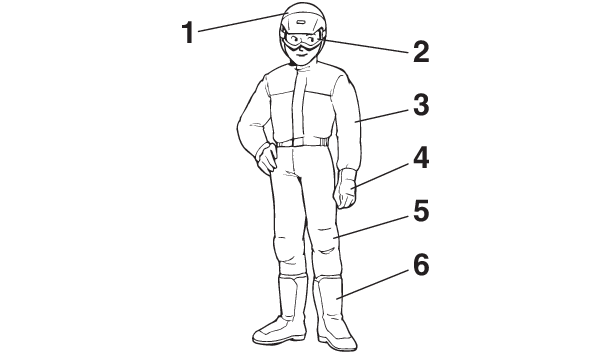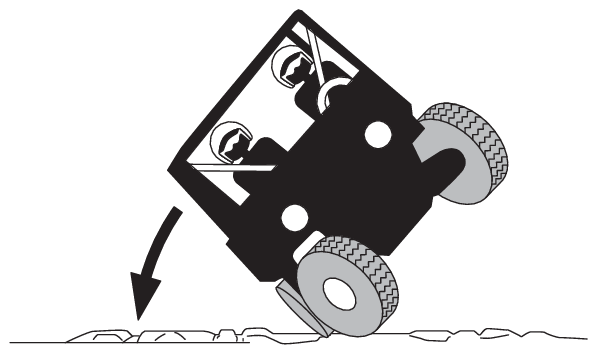LEARNING TO OPERATE YOUR VEHICLE
Personal protective equipment

- Approved motorcycle helmet
- Eye protection
- Long-sleeved shirt or jacket
- Gloves
- Long pants
- Over-the-ankle boots
The driver and passengers should wear the following to reduce risk of injury in an accident:
- Approved motorcycle helmet that fits properly
- Eye protection (goggles, helmet face shield, or protective eyewear)
- Over-the-ankle boots, gloves, long-sleeved shirt or jacket, and long pants
An approved helmet and other personal protective equipment can help in a variety of ways, including:
- Reduce the severity of injuries if any part of you is outside the vehicle cage/frame protective structure during a rollover.
- Help protect you if outside objects intrude inside the vehicle during operation.
- Help protect you in the event of vehicle impact with an obstacle.
Wear eye protection when operating or riding in the vehicle to reduce the risk of a serious accident or injury. Eye protection, such as a face shield or goggles, may reduce the risk of foreign material getting in your eyes and help prevent loss of vision.
Practice for new Yamaha Wolverine RMAX4 users
You should become familiar with the performance characteristics of the vehicle in a large, flat area that is free of obstacles and other vehicles. Practice controlling the accelerator pedal, brakes, steering, and drive select lever. Drive at slow speeds with gradual acceleration and turning. Practice smooth throttle application. Practice slowing down before turning. Practice maintaining a steady throttle through the turn. Avoid higher speeds until you are thoroughly familiar with the operation of your vehicle. Remember, driving aggressively or making abrupt maneuvers even on flat, open areas can cause side rollovers.

Become familiar with the way the vehicle feels in low and high ranges, first in two-wheel drive “2WD” and then in four-wheel drive “4WD” and four-wheel drive with the differential locked “DIFF. LOCK”. Steering may take more effort in four-wheel drive with the differential locked “DIFF. LOCK”. Also practice driving in reverse.
Take the time to learn basic operation of the vehicle before attempting more difficult maneuvers.
Getting ready to ride
Perform the Pre-Operation Checks on page . Follow the instructions starting on page to start the engine.
Turning
Use care in turns – turning the steering wheel too far or too fast can result in loss of control or a rollover. Slow down before entering turns. When making tight turns from a standstill or at slow speeds, avoid sudden or hard acceleration. Driving aggressively or making abrupt maneuvers even on flat, open areas can cause side rollovers. Avoid sideways sliding, skidding, or fishtailing (rear-wheel sliding), and never do donuts. If you feel the Wolverine RMAX4 begin to slide sideways or the rear wheels begin to slide during a turn, steer into the direction of the slide, if possible, and gradually let off the accelerator pedal to regain directional control and avoid rollover. For example, if you feel the back of the vehicle start to slide to your right, steer to the right.
If you think or feel that the vehicle may tip or roll, keep your body completely inside the protective structure of the vehicle:
- Brace yourself by pressing your feet firmly on the floorboard and keep a firm grip on the steering wheel or passenger handhold.
- Do not put your hands or feet outside of the vehicle for any reason. Do not try to stop a tipover using your arm or leg.
Accelerating
With the engine idling in neutral and your foot on the brake, shift the drive select lever into low or high. NOTICE: Do not shift from low to high or vice versa without coming to a complete stop and waiting for the engine to return to normal idle speed – damage to the engine or drive train may occur. Then release the parking brake. Press the accelerator pedal slowly and smoothly. The centrifugal clutch will engage and the vehicle will begin to accelerate.
Avoid higher speeds and sudden or hard acceleration until you are thoroughly familiar with the operation of your vehicle. Avoid sudden or hard acceleration in any turn.
Braking
When slowing down or stopping, take your foot off the accelerator pedal and press the brake pedal smoothly. Improper use of the brakes can cause the tires to lose traction, reducing control of the vehicle and increasing the possibility of an accident.
Braking ability is affected by type of terrain. In most cases, gradual application of the brakes is more effective than abrupt braking, particularly on loose surfaces, such as gravel. Always allow for greater braking distance on rough, loose, or slippery surfaces.
Engine braking
Engine compression braking is designed to assist you when operating your Wolverine RMAX4 off-road. With this feature, the engine helps slow the vehicle down after you take your foot off the accelerator. Engine braking is more noticeable in four-wheel drive. Application of vehicle brakes provides additional stopping power.
Leaving the vehicle
Do not get out of the vehicle while the engine is running and the drive select lever is in any gear. There is a risk of injury because:
- Children or others may accidentally press the accelerator pedal.
- Objects tossed into the vehicle may strike the accelerator pedal.
- The parking brake may not keep the vehicle from accelerating.
Unwanted vehicle movement can cause serious injury or death, and it may be dangerous to try to stop the vehicle.
Parking on a flat area
When parking on a flat area, stop the engine and shift the drive select lever into the neutral position. Apply the parking brake to help prevent the vehicle from rolling.
Parking on a slope
The parking brake acts only on the rear wheels when in “2WD”. For the parking brake to take effect on all four wheels, shift to “DIFF. LOCK” before stopping the engine.
If you park on a hill that is too steep the vehicle may roll out of control. Never park on hills that are so steep you cannot walk up them easily. If you must park on an incline follow these instructions:
Bring the vehicle to a stop by applying the brake pedal.
Put the vehicle in “DIFF. LOCK”.
Turn the key to “
 ” (off).
” (off).With the brake pedal applied, set the parking brake.
Block the front and rear wheels with rocks or other objects.